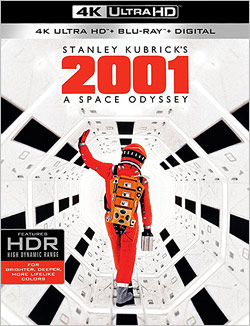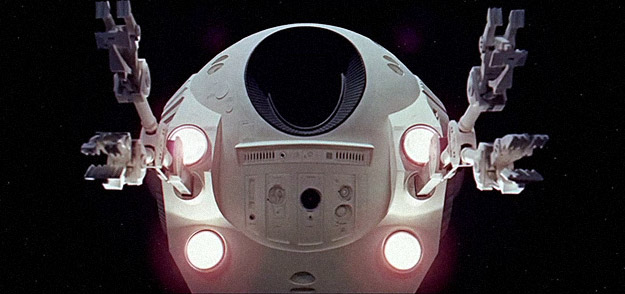
Coate: In what way was Stanley Kubrick an ideal choice to direct 2001 and where does the film rank among his body of work?
Barsanti: Kubrick is probably the only director at that time who was comfortable with trimming away all the extraneous plotting that other filmmakers would have tagged on to this journey. He was after spectacle and discovery and expansion of consciousness: some subplot about the broken family Dave had left behind on Earth would have just cluttered things up. In terms of his body of work, 2001 is the last great thing Kubrick achieved. After this, his body of work became increasingly self-indulgent and dry, without the dark wit and sparkle of his earlier movies and little of 2001’s visual and philosophical grandeur.
Benson: I believe 2001 is Kubrick’s crowning achievement. It’s the movie that launched him into “superstar” status that placed him alongside the likes of Welles, Bergman, Fellini, Kurosawa, Hitchcock, Ford... I can’t imagine anyone else directing the film or even conceiving of it, for the picture is full of many of Kubrick’s thematic signatures — man’s inhumanity to man, the flaws of being human, how technology can be a danger — but I also think he uses these themes, at the end of the picture, in an optimistic way. There is hope for mankind in the final image of the Star-Child. Man will evolve into something greater. Someday. Maybe.
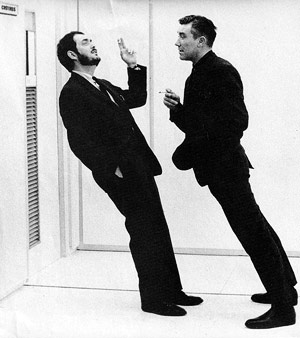 Krämer: I don’t think one can say that Kubrick was “chosen” to direct 2001. He developed the whole project from scratch. Soon after the release of Dr. Strangelove, he contacted Arthur C. Clarke, one of the world’s leading science fiction writers and also the author of many popular science books, and asked him whether he wanted to collaborate on developing a story for a science fiction film which would center on humanity’s encounter with an extraterrestrial civilization.
Krämer: I don’t think one can say that Kubrick was “chosen” to direct 2001. He developed the whole project from scratch. Soon after the release of Dr. Strangelove, he contacted Arthur C. Clarke, one of the world’s leading science fiction writers and also the author of many popular science books, and asked him whether he wanted to collaborate on developing a story for a science fiction film which would center on humanity’s encounter with an extraterrestrial civilization.
As is evidenced by many public and private statements, Kubrick was deeply convinced that humanity was very likely to destroy itself in an all-encompassing nuclear war in the not too distant future, and in Dr. Strangelove he had shown how this might happen. But he also felt that there was a slim chance that humanity might be transformed and avoid this terrible fate.
Well, if you are convinced that humanity will destroy itself on Earth, where do you look for an alternative? To heaven, of course. If you are religious, you might hope for God’s intervention. If not (and neither Kubrick nor Clarke were religious), you hope for an encounter with something transformative in space, or perhaps you hope that simply going into space might give humanity a new perspective and thus transform it. That was, I am convinced, the main driving force behind the making of 2001.
It is also the case that only Kubrick would have been able to make a film like this at this point in time. This was a big budget movie from the outset, and it nominally belonged to a genre — science fiction — which, with very few exceptions, had never done particularly well at the box office. But Kubrick had an excellent commercial track record; his last three films — Dr. Strangelove, Lolita and Spartacus — had all been hits, and he was also already widely regarded as one of the greatest American filmmakers. So he managed to get MGM to finance what was initially called Journey Beyond the Stars. And then he took much, much longer than expected and went massively over budget. But in the light of Kubrick’s reputation and track record, the studio did not interfere.
And then he did something so amazing that even today I completely baffled. For several years, 2001 was meant to have had a prologue showing interviews with scientists talking about topics important for understanding the film, a voiceover narration which explained and commented on what was happening in the story, long dialogue sequences which did the same, and a conventional score. But not long before the film’s release in April 1968, Kubrick, one after the other, removed all these elements. He thought that the film would work better if it was just as mysterious as the monoliths at the center of its story (and the pre-recorded music he used, especially Ligeti’s eerie compositions, really helped to create this mystery, already starting with the overture).
It is truly astonishing that even at this point MGM didn’t interfere to protect the huge investment the studio had made. But either the top executives trusted Kubrick’s judgment that this mysterious film would work with a mass audience, or they were simply too caught up in internal power struggles to have much time for 2001. As it turned out, Kubrick was right. 2001 became one of the highest grossing films of all time in the United States.
Pfeiffer: Some years ago, I was writing and co-producing a documentary for Sony about the making of Dr. Strangelove. Among the people we interviewed was Roger Caras, a former executive in publicity for Columbia Pictures. Kubrick had been impressed with the offbeat ad campaign Roger had overseen for Strangelove, a minimalist cartoon that depicted the U.S President and Soviet Premier both on the Hot Line. Shortly thereafter, Kubrick took Roger to lunch at Trader Vic’s in New York City, ostensibly for lunch. However, he had another purpose. He informed Roger that his next film would be his most ambitious and would involve space travel and have a very existential aspect to it. Roger very much respected Kubrick’s instincts and listened intently as Kubrick outlined the bare-bones scenario for what would become 2001: A Space Odyssey. Kubrick explained that he didn’t want this to be some kind of sci-fi thriller, but the most intelligent examination of the space age ever undertaken. Furthermore, his original concept (dropped from the finished film) would center on the first meeting between human beings and aliens. Roger said that Kubrick drew some rough “stick man”-like figures on the back of a Trader Vic’s napkin to illustrate the fact that the aliens would be much taller than a human being.
As the conversation continued, Kubrick shocked Roger by imploring him to quit his executive position at Columbia to work full time on the space film project, which was untitled at that time (this was 1964). Kubrick assured him that it would take years from concept to completion. He also said he wanted Roger to fly to different nations to interview prominent scientists for a prologue he intended to use in the finished film. It was important to Kubrick that the movie had gravitas and be grounded in realistic scientific concepts. Roger came home and informed his shocked wife that he was indeed going to quit his job and work with Kubrick. His rationale: Kubrick was the only true genius he had ever known. Not just a filmmaking genius, but a genuine genius who was conversant in virtually every subject. Roger had been friendly with the writer Arthur C. Clarke, who lived in Ceylon. He told Kubrick to read his works and Kubrick did just that. He was impressed by a story Clark had written, The Sentinel and contacted the author about the possibility of using it as an inspiration for his space film. Clarke was so enthused about the project that he agreed to co-author the screenplay with Kubrick. The rest, as they say, is history. The interviews with scientists that Roger had so painstakingly completed were also cut before the release print was finalized because a screening with MGM executives resulted in the feeling that it got the movie off to a slow and turgid start. An interesting side note: when our interview with Roger Caras was complete, he went into one of his files and said he would show us something priceless. He removed the original Trader Vic’s cocktail napkins that Kubrick had doodled his concepts on. When I asked him what possessed him to keep them at the time, he said that anything in writing from Kubrick had potential historical value. He was right.
Roger Caras disputed the popular legend that Stanley Kubrick was a recluse. He acknowledged he had eccentricities but was not insulated from the world. Kubrick filmed Dr. Strangelove in England and became enamored of the UK. He would only leave the UK one more time, when he had to show the original cut of 2001 to MGM executives in America. Kubrick, a former pilot, had experienced a near-death trauma when flying his private plane. He never flew again. Roger said that for reasons Kubrick never explained, he would not travel above 30 mph in any vehicle, which made accompanying him on the road an exasperating experience. Aside from these quirks, however, Roger said Kubrick enjoyed being in a group of intelligent, eclectic people and occasionally hosted parties at his estate. Roger said it was sheer bliss seeing legends from the worlds of politics, art, cinema and literature all meeting and engaging in conversation.
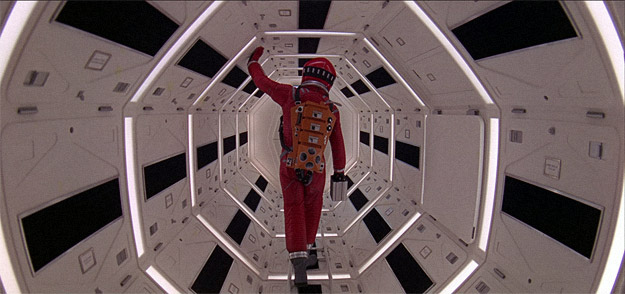
Coate: How would you describe 2001 to someone who has never seen it?
Benson: Since I screen it for young college-age film students, many have not seen it. I warn them that it is meticulously-paced, and that they will most likely find parts of it to be slow. I preface this with the fact that movies moved much slower prior to the 1980s and the advent of MTV. I explain that this has a hypnotic effect for audiences who accept the pace for what it is, settle into it, and let the movie envelop them. I then go on to say it is considered by many (including the AFI) to be the #1 science fiction film of all time, and how it leaves the audience to interpret it as they choose. Usually students are more receptive to it after a proper introduction that places the film within the context of when it was released.
Krämer: I think that today people are likely to have all kinds of preconceptions before they watch 2001, mainly to do with its status as a masterpiece and also perhaps as an expression of Kubrick’s pessimism. I wish that people could just drop these preconceptions, and approach the film as if they were going on a journey, a journey into the unknown. After all, the film has “odyssey” in its title.
One has to expect to get lost for a while on this odyssey, but one can also be certain to be returned home safely. It is best to experience each stage of the journey in its own right, because there are so many sounds and images, actions and motifs to contemplate. Perhaps one can use the intermission (which appears on most DVD and Blu-ray editions) to actually take a break and think about what one has seen and heard, and how the preceding stages of the journey relate to each other, and where the journey might go next.
At the end of the film, it is only fitting if one allows oneself to be haunted by the final image of the Star-Child looking directly at the camera and thus at the audience. One can explore how this image relates to the title shown right after the opening credit sequence: The Dawn of Man. What does all this tell us about what it means to be human? And about human history?
So my best advice would be to keep an open mind when watching 2001, to try to experience everything it has to offer, and to go away from it with many questions rather than with simple answers.
Coate: Any thoughts on the film’s sequel?
Krämer: I actually like 2010 quite a lot. The only problem is that it is pales in comparison with Kubrick’s film. It is difficult to watch it without constantly comparing it with 2001, and it is diminished by this comparison. Otherwise it is a perfectly engaging and stimulating film. I have read all the sequel novels that Clarke wrote and also the “time odyssey” novels he wrote together with Stephen Baxter. There are some wonderful ideas here, but, again, nothing quite lives up to the magical experience of watching Kubrick’s film.
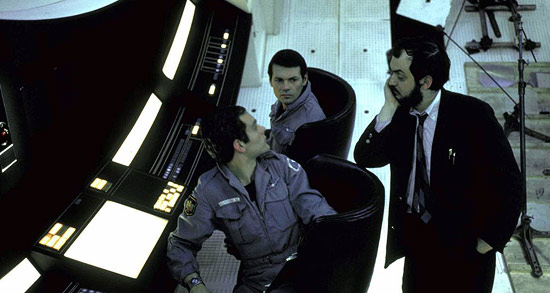
Coate: Has 2001 been well-served on its numerous home-video releases? Is it worth watching in the home?
Benson: It’s made to be seen on the big screen — the bigger the better — and with a good sound system. Kubrick wanted the film to overwhelm an audience. Back in the 1980s, 2001 was the first VHS tape I bought, and I really hated the pan-and-scan version. A widescreen version came out a little later, and that helped, but it was no substitute for the big screen. DVD improved this, and then we got flat screen, widescreen televisions and Blu-ray. This helped immensely. I believe that if you have a really good home theater setup with a big TV screen, sound, and Blu-ray, in a darkened room with no distractions, you can recreate a decent experience watching the film (or any film, for that matter!).
Krämer: In my experience of watching 2001 dozens of times, it works on small screens as well as on big ones. Of course, it is a very special treat to see the film on a huge screen, perhaps even on an old Cinerama screen (as I once did in Bradford in the UK). But one can also immerse oneself when watching it on a television set, especially if it is large one with good sound. I think watching it while being alone may actually add something to the experience, especially when one is confronted with the Star-Child at the end. I have to admit that I never tried to watch it on a tablet or a smart phone. I wonder what that would be like.
Coate: What is the legacy of 2001?
Benson: As said above — it remains the #1 science fiction movie of all time. For me personally it’s the #1 movie of all time because it quite frankly changed my life. I had loved motion pictures prior to 2001, but after it I became seriously interested in the craft and history of cinema. I’ve seen it maybe a hundred times, and I continue to find new things to admire. It will always inspire and move me.
Krämer: The legacy of 2001 is difficult to map, because so many people were deeply affected by this film. Some, such as myself, became film scholars. More importantly, others, such as James Cameron, became film makers (in fact I am a great admirer of Cameron’s work, and I think that Avatar is the most powerful reworking of 2001 that we have seen in a long time). There are also no doubt many people who were inspired to get into space exploration and SETI (the search for extraterrestrial intelligence) or artificial intelligence research. Judging by the letters from cinemagoers Kubrick received, numerous people also simply felt that their lives did not have to go on as before, that change was possible, that everything was possible. Who knows what they eventually did with this feeling!?
Pfeiffer: The legacy of 2001 is apparent in the fact you are doing a major article about it 50 years later. Kubrick and Arthur C. Clarke strove to challenge people’s imaginations and they succeeded. There are so many landmark visuals in the film, we can’t recount them here. It’s been criticized for being a cold, antiseptic film when it comes to exploring the human condition — and it is indeed that. However, Kubrick wasn’t interested in the viewers getting under the skins of the characters. If he was, he would have cast big box office names in the lead roles. Instead, he wanted to create a film that had a legacy that would last for many years and he certainly succeeded in that. The film inspired a new generation of filmmakers and continues to do so today. Doubtless, it will continue to do so even 50 years from now.
Coate: Thank you — Chris, Raymond, Peter, and Lee — for sharing your thoughts about Stanley Kubrick’s 2001: A Space Odyssey on the occasion of its 50th anniversary.
--END--
IMAGES
Selected images copyright/courtesy Metro-Goldwyn-Mayer, MGM/UA Home Entertainment, Stanley Kubrick Productions, Warner Home Video. 70mm frames scanned by Schauburg Archive. Home-video collage by Cliff Stephenson. Roadshow ticket stub from the collection of Robert Morrow. Raymond Benson photo by Katherine Tootelian.
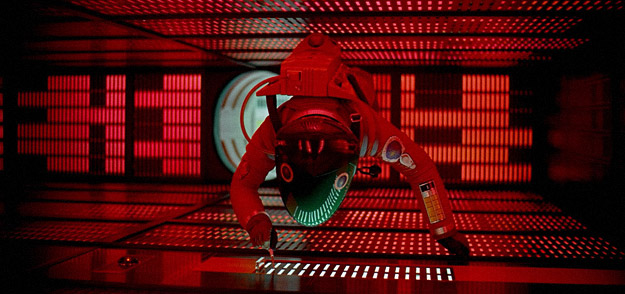
SOURCES/REFERENCES
The primary references for this project were regional newspaper coverage and trade reports published in Billboard, Boxoffice, The Hollywood Reporter and Variety. All figures and data included in this article pertain to the United States and Canada except where stated otherwise. This work is based upon articles by same author previously published at In70mm.com and CinemaTreasures.org.
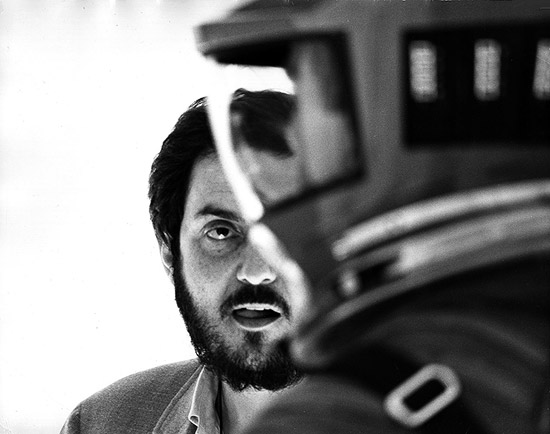
SPECIAL THANKS
Al Alvarez, Jim Barg, Chris Barsanti, Don Beelik, Raymond Benson, Kirk Besse, Herbert Born, Serge Bosschaerts, Raymond Caple, Miguel Carrara, Evans A. Criswell, Nick DiMaggio, Carlos Fresnedo, Sheldon Hall, Thomas Hauerslev, William Hooper, Bill Huelbig, Mark Huffstetler, Peter Krämer, Bill Kretzel, David Larson, Ronald A. Lee, Mark Lensenmayer, Paul Linfesty, Stan Malone, Robert Morrow, Gabriel Neeb, Jim Perry, Lee Pfeiffer, Richard Ravalli, Jochen Rudschies, Sam Shapiro, Grant Smith, Cliff Stephenson, Bob Throop, Joel Weide, and Vince Young, and an extra special thank-you to all of the librarians who helped with this project.
IN MEMORIAM
- H.L. Bird (Sound Mixer), 1909-1968
- A.W. Watkins (Sound Supervisor), 1895-1970
- Geoffrey Unsworth (Director of Photography), 1914-1978
- James Liggat (Casting), 1920-1981
- Wally Veevers (Special Photographic Effects Supervisor), 1917-1983
- Leonard Rossiter (“Dr. Andrei Smyslov”), 1926-1984
- Sean Sullivan (“Dr. Bill Michaels”), 1921-1985
- Tom Howard (Special Photographic Effects Supervisor), 1910-1985
- John Alcott (Additional Photography), 1931-1986
- Alan Gifford (“Poole’s Father”), 1911-1989
- Tony Masters (Production Designer), 1919-1990
- Ernest Archer (Production Designer), 1910-1990
- Robert Beatty (“Dr. Ralph Halvorsen”), 1909-1992
- William Sylvester (“Dr. Haywood R. Floyd”), 1922-1995
- John Hoesli (Art Director), 1919-1997
- Frank Miller (“Mission Controller – Voice”), 1944-1998
- Stanley Kubrick (Writer-Producer-Director-Special Effects Designer/Director), 1928-1999
- Winston Ryder (Sound Editor), 1915-1999
- Ray Lovejoy (Editor), 1939-2001
- Edward Bishop (“Aries-1B Lunar Shuttle Captain”), 1932-2005
- Arthur C. Clarke (Writer), 1917-2008
- Harry Lange (Production Designer), 1930-2008
- Margaret Tyzack (“Elena”), 1931-2011
- Bill Weston (“Astronaut”), 1941-2012
- Stuart Freeborn (Makeup), 1914-2013
- Frederick I. Ordway III (Scientific and Technical Consultant), 1927-2014
- Ann Gillis (“Poole’s Mother”), 1927-2018
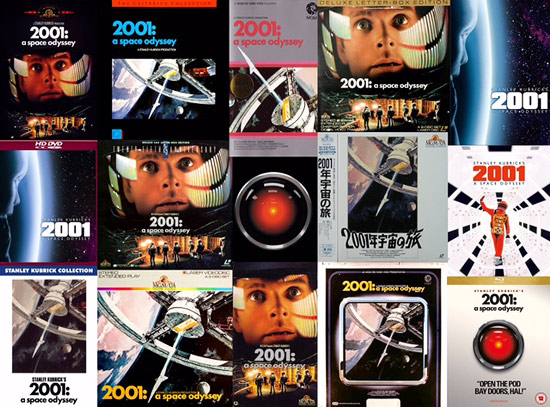
-Michael Coate
Michael Coate can be reached via e-mail through this link. (You can also follow Michael on social media at these links: Twitter and Facebook)



